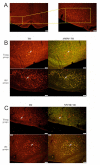Attenuation of the Counter-Regulatory Glucose Response in CVLM C1 Neurons: A Possible Explanation for Anorexia of Aging
- PMID: 35327640
- PMCID: PMC8945993
- DOI: 10.3390/biom12030449
Attenuation of the Counter-Regulatory Glucose Response in CVLM C1 Neurons: A Possible Explanation for Anorexia of Aging
Abstract
This study aimed to determine the effect of age on CVLM C1 neuron glucoregulatory proteins in the feeding pathway. Male Sprague Dawley rats aged 3 months and 24 months old were divided into two subgroups: the treatment group with 2-deoxy-d-glucose (2DG) and the control group. Rat brains were dissected to obtain the CVLM region of the brainstem. Western blot was used to determine protein expression of tyrosine hydroxylase (TH), phosphorylated TH at Serine40 (pSer40TH), AMP-activated protein kinase (AMPK), phosphorylated AMPK (phospho AMPK), and neuropeptide Y Y5 receptors (NPY5R) in CVLM samples. Immunofluorescence was used to determine TH-, AMPK-, and NPY5R-like immunoreactivities among other brain coronal sections. Results obtained denote a decrease in basal TH phosphorylation levels and AMPK proteins and an increase in TH proteins among aged CVLM neurons. Increases in the basal immunoreactivity of TH+, AMPK+, NPY5R+, TH+/AMPK+, and TH+/NPY5R+ were also observed among old rats. Young treatment-group rats saw a decrease in TH phosphorylation and AMPK proteins following 2DG administration, while an increase in AMPK phosphorylation and a decrease in TH proteins were found among the old-treatment-group rats. These findings suggest the participation of CVLM C1 neurons in counter-regulatory responses among young and old rats. Altering protein changes in aged CVLM C1 neurons may attenuate responses to glucoprivation, thus explaining the decline in food intake among the elderly.
Keywords: anorexia of aging; catecholaminergic neurons; caudal ventrolateral medulla; feeding response; glucoprivation.
Conflict of interest statement
The authors declare no conflict of interest.
Figures




Similar articles
-
Effects of age on feeding response: Focus on the rostral C1 neuron and its glucoregulatory proteins.Exp Gerontol. 2020 Jan;129:110779. doi: 10.1016/j.exger.2019.110779. Epub 2019 Nov 6. Exp Gerontol. 2020. PMID: 31705967
-
Distribution and neurochemical characterization of neurons in the rat ventrolateral medulla activated by glucoprivation.Brain Struct Funct. 2015 Jan;220(1):117-34. doi: 10.1007/s00429-013-0642-3. Epub 2013 Oct 8. Brain Struct Funct. 2015. PMID: 24100548
-
Participation of hindbrain AMP-activated protein kinase in glucoprivic feeding.Diabetes. 2011 Feb;60(2):436-42. doi: 10.2337/db10-0352. Diabetes. 2011. PMID: 21270255 Free PMC article.
-
Effects of age on the glucoregulatory response following acute glucoprivation induced by 2-deoxyglucose (2DG) in the adrenal medulla of Sprague Dawley rats.Neuro Endocrinol Lett. 2017 Jul;38(3):224-235. Neuro Endocrinol Lett. 2017. PMID: 28759191
-
Hindbrain glucoregulatory mechanisms: Critical role of catecholamine neurons in the ventrolateral medulla.Physiol Behav. 2019 Sep 1;208:112568. doi: 10.1016/j.physbeh.2019.112568. Epub 2019 Jun 5. Physiol Behav. 2019. PMID: 31173784 Free PMC article. Review.
Cited by
-
Exploring the association between relative fat mass and psoriasis risk: insights from the NHANES data.Lipids Health Dis. 2025 Jun 9;24(1):210. doi: 10.1186/s12944-025-02615-5. Lipids Health Dis. 2025. PMID: 40490769 Free PMC article.
-
Resveratrol in the Hypothalamic Paraventricular Nucleus Attenuates Hypertension by Regulation of ROS and Neurotransmitters.Nutrients. 2022 Oct 7;14(19):4177. doi: 10.3390/nu14194177. Nutrients. 2022. PMID: 36235829 Free PMC article.
References
Publication types
MeSH terms
Substances
LinkOut - more resources
Full Text Sources

